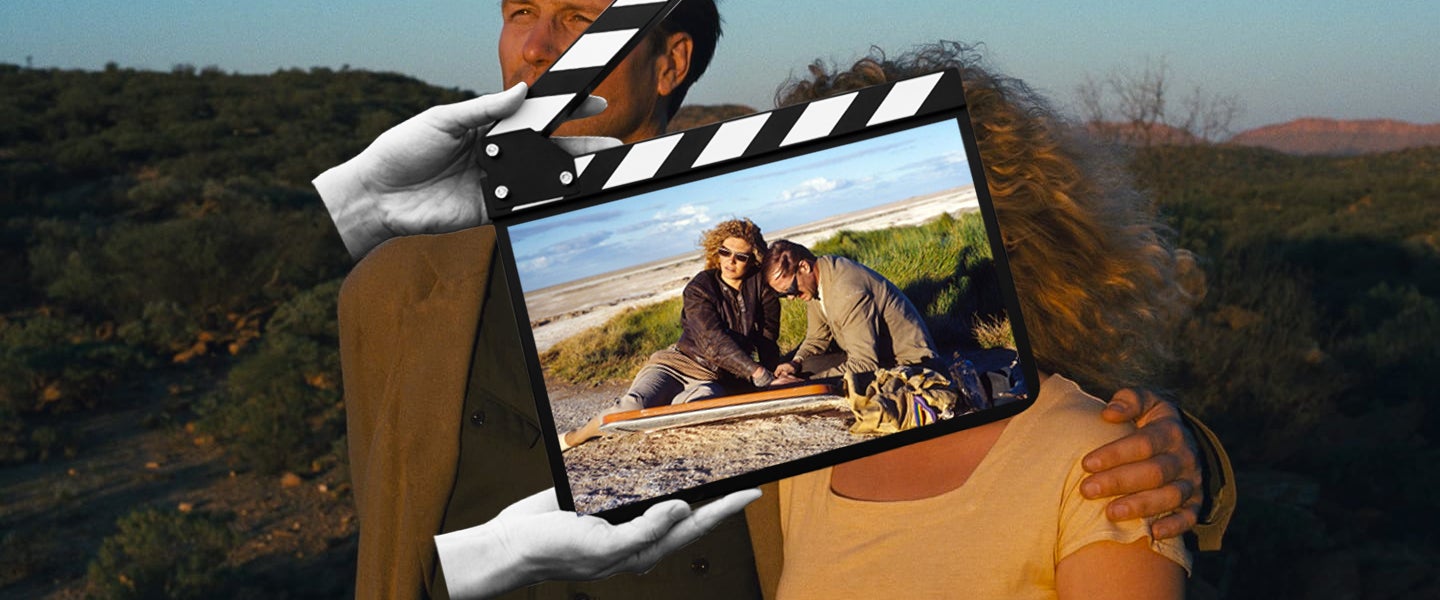What if one of the world’s most renowned directors, working at the height of his commercial popularity, made his most ambitious film — a futuristic road movie shot in nine countries across four continents — and nobody saw it?
That’s more or less what happened in the final days of 1991 and the early weeks of 1992 when a few — very few — American moviegoers saw Wim Wenders’ Until the End of the World during its initial run (at the height of its release, it played 22 theaters). To do so, they had to carve out a significant amount of time, since the film approached three hours. But that wasn’t, by Wenders’ reckoning, enough time: His preferred cut approached a staggering five hours. He’d proposed releasing the film in two parts but lost the battle, so a shorter version came and went and, ordinarily, that would have been the end of it in the days when the term “director’s cut” didn’t have much meaning to the average moviegoer.
Unexpectedly, that changed before the corpse of Until the End of the World had even had time to cool. By the end of 1992, Blade Runner: The Director’s Cut would put a significantly altered version of a 10-year-old science fiction flop-turned-cult item back into the cultural conversation. It soon inspired others to revisit old material and make it new, in the process destabilizing what we thought of as a finished movie.
2019 suggests we’re still figuring it out. While passionate corners of the internet broke out in cries to “Release the Snyder Cut,” a director’s cut of Zack Snyder’s Justice League that may or may not even exist, Until the End of the World reemerged in Wenders’ preferred form — all 287 minutes of it — via a Criterion Collection Blu-ray edition. The two movies might not seem to have that much in common, but they’re ultimately examples of the same battle, one concerning who gets the final say on how a movie will be seen and remembered.
It is, of course, an old battle. Directors have fought with producers and studios to preserve their vision since film began — it just used to be a battle with a definitive winner. Orson Welles lost control of The Magnificent Ambersons, and whatever he originally had in mind for its final act ended up at the dump when RKO needed to clear up some storage space. For decades, a movie released to theaters was the version of that movie, forever and ever. (Some feel it should still be this way: Martin Scorsese, for instance, believes the released version is the definitive version, and considering there’s almost certainly a better version of Gangs of New York somewhere in the Weinstein vaults, he obviously takes that view seriously.)
Exceptions did pop up, like a more violent version of The Wild Bunch that screened in the 1970s, and a version of Heaven’s Gate that started to turn around the reputation of that troubled film when it aired on the influential L.A. cable station Z Channel during the 1980s. In 1980, Steven Spielberg released a “Special Edition” of Close Encounters of the Third Kind with some new footage (true, it weakened the film, but it still suggested a finished film wasn’t always truly finished). In 1991, Warner Bros. quietly released the full version of Sergio Leone’s Once Upon a Time in America on VHS after releasing a much shorter edit in theaters seven years earlier. Roger Ebert called the cut version a “murdered movie,” and that only sounds like hyperbole if you don’t know what the studio did to the sprawling, difficult masterpiece.
But it would be Blade Runner that served as a turning point, and it would take fans to make it happen. 1990 and 1991 saw several theaters screen a workprint version of Blade Runner. It didn’t represent Ridley Scott’s final vision for the film, but it also didn’t include edits imposed by the studio, like the addition of Harrison Ford’s weary running narration and a happy ending. Sensing money could be made, Warner Bros. worked with Scott to create and release Blade Runner: The Director’s Cut, which became a hit in a limited theatrical run, and then again on home video, where it helped expand the film’s following.
After this, the floodgates opened. In 1993, James Cameron released a new cut of The Abyss containing effects and storylines not seen in the 1989 original. In the process, he effectively created a substantially different film, one in large part about the threat of nuclear annihilation. A different Orson Welles film, Touch of Evil, returned to theaters in 1998 in a version far closer to what Welles originally wanted. In 2001, the Coen brothers released a director’s cut of their debut, Blood Simple, one that made it slightly shorter. Want to see The Exorcist, Apocalypse Now, and E.T. again? Why not see them with even more scenes than they had before?
On the home video front, director’s cuts became an option for incorrigible tinkerers like Michael Mann, who’s prone to work and rework his films, and a consolation prize for those who found themselves compelled to release different, usually shorter versions of their movies than they might like. These included Cameron Crowe, whose Almost Famous received a “Bootleg Cut” for DVD, and Ridley Scott, who never let go of the director’s cut habit and brought it to later films like Kingdom of Heaven and The Counselor. A second chance to get it right could take the sting out of a compromise. In some cases, directors’ cuts and extended versions were always part of the plan, as with the Lord of the Rings films.
There’s a downside to this, though. As alternate versions piled up, director’s cuts and special editions started to feel less, well, special. And some were just bad: A fan edit of Superman II trying to restore the vision of original director Richard Donner before he was fired from the film evolved into the officially released Superman II: The Richard Donner Cut, a patched-together mess that, for a while, became easier to find than the proper version. Richard Kelly took a second pass at Donnie Darko that clarified some of its mysteries but made it a lesser film in the process. Alien — yet another Ridley Scott film — appeared in a “director’s cut” that offered no improvements or much in the way of substantial changes. That kind of gave the game away: slap “director’s cut” on a poster or a DVD case and you could sell the same movie twice, even ones that seemed beyond the help of a director’s cut. (What kind of miracle could make Daredevil watchable?)
In 2019, we’re living in a movie world Blade Runner: The Director’s Cut helped create, as a quick scan through a streaming rental service will confirm. (Ah, at last, an even longer version of Fate of the Furious.) But does a director’s cut mean anything anymore? Cut through the issues around the phenomenon and the answer still remains “yes” for a simple reason: Some films need a second shot at getting seen as they were meant to be seen.
Look no further than Until the End of the World for a perfect example. Knowing he’d have to cut the film, Wenders surreptitiously held on to both the work print he’d assembled and the film’s negative. Starting in 1993, he began to show his version for small crowds at special screenings. Word of mouth spread, and while the shorter cuts moldered on video-store shelves, the original cut started to take on a life of its own. It received a small release in 2015, an airing on TCM in 2017 and now the Criterion treatment.
Watching it now reveals a fascinating film that deserves its revival, at least in this form. I watched Until the End of the World on VHS years ago and can barely recall the experience. I mostly remember feeling bored by it even though other Wenders films I watched around that time made a deep impression. (Kings of the Road, three hours of two men driving up and down the border between East and West Germany repairing movie projectors in aging theaters, became one of my favorite movies.) In its shorter version, Until the End of the World seems ponderous and inconsequential. But at five, it moves at the pace it should, as a mismatched bunch of characters slowly make their way across Europe, then through Asia to the Australian outback by way of San Francisco in the then-near future of 1999, all to the tune of an all-star soundtrack that included songs from Nick Cave, U2, R.E.M., Depeche Mode and others (the soundtrack album become a hit in spite of the film attached to it).
What’s more, Until the End of the World plays differently now than it would have in the early 1990s. Then, when few had access to the early-days internet, the film’s clunky-but-effective search engines that eliminate the ability to disappear looked fanciful. Now they appear prophetic. That applies tenfold to a late-film development in which characters, having achieved the ability to record their dreams, become slaves to those recordings. They change into solipsists, addicted to handheld devices that reflect their deepest yearnings back to them as they ignore the world around them. Squint, and the film starts to look a bit like a documentary.
All of which is a long way of saying, “Release the Snyder Cut.” Why not? If you hold to the logic that Wenders’ version of Until the End of the World should be seen, you have to extend that to Zack Snyder as well. Sure, some might argue that Snyder peaked with 300 (and that even 300 had really troubling qualities). Some might argue that both Man of Steel and Batman v Superman: Dawn of Justice demonstrate that he has no real feel for DC superheroes, and that he makes films designed to appeal to the basest power fantasies of the superhero audience. Some might argue that his Justice League, based on all available evidence, will almost certainly be bad. But there’s no arguing that Snyder has a vision and that there’s both a desire on his part to share it — rumors have surfaced that he’s been showing something to select circles and those tweets from cast members didn’t come out of nowhere — and there’s undoubtedly a highly vocal audience eager to see it.
If it’s terrible, it’s terrible. It certainly wouldn’t be the first director’s cut to make a movie worse. For every change as remarkable as the restored unicorn dream sequence in Blade Runner, there’s a “McClunkey!” But for all their shortcomings, director’s cuts have made the movie landscape richer, more vital and less predictable, a place where a spectacular arthouse flameout from 30 years ago can return with an unforgettable glimpse at an imagined future, with much to say about your present. The continued existence of director’s cuts may mean inviting endless, tedious arguments about how Superman’s black suit is more awesome than anything Joss Whedon ever created. But it also means, sometimes, a murdered film like Until the End of the World gets a second life.

